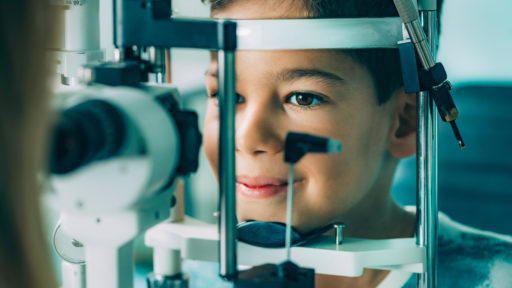A corneal ulcer is an open sore on your cornea, the windshield of your eye. In most cases it is caused by an infection, but this can also be due to decreased nerve sensation.
Corneal ulcers can happen in people of any age. Risk factors include eyelid margin disease, contact lens wear, trauma, underlying autoimmune disease and uncontrolled diabetes. If not treated, a corneal ulcer can lead to corneal scarring, decreased vision and even blindness.
What causes a corneal ulcer?
- Bacterial infections, such as Staphylococcus
- Viral infections, such as herpes
- Fungal infections
- Parasitic infections
- Scrapes or burns on the cornea
- Conditions that dry out the cornea, such as dry eye or Bell’s palsy
- Autoimmune diseases, such as rheumatoid arthritis
- Injury to the cornea
- Ulcers from reduced blood flow, such as from diabetes
- Allergies causing inflammation of the eyes
- Vitamin A deficiency (rare in the U.S.)
If you use contact lenses, you are more at risk for a corneal ulcer if you:
- Wear soft contact lenses
- Wear extended-wear contact lenses
- Wear your lenses for longer than recommended
- Don’t care for your lenses and lens case as advised by your medical team
- Put your contact lenses in water
Symptoms of a corneal ulcer
- Severe eye pain
- Excessive Tearing
- Pus-like discharge from your eye
- Severe sensitivity to light
- Blurred vision
- Eye redness
- Swelling of your eyelids
- A white spot on your cornea
Diagnosing a corneal ulcer
One of our experts will ask about your past health and your symptoms, and you will be given a thorough medical eye exam. Your eyesight will be checked in both eyes, and a dye may be put into your eye to help your eye doctor look at your cornea. He or she may use an ophthalmoscope, which uses a light to look into the back of your eye. You may be asked to look into a large tool called a slit-lamp so that your eye doctor can see your eye in more detail.
Your cornea may be scraped and the sample sent to a lab to check for infection. If you wear contact lenses, your contact lenses may be sent to the lab too. You may also have blood tests to help find the cause of your corneal ulcer, and our experts will provide the best personalized treatment for your needs.
Types of treatment
- Eye drops and ointments, such as antibiotic, antiviral or antifungal
- Steroid eye drops
- Serum tear eye drops
- By mouth antibiotics, antivirals or antifungals
- Your doctor may also give you instructions about protecting your eye as it heals. For example, you may need to wear special contact lens or have your eyelid temporarily closed. Do not wear your normal contact lenses unless your healthcare provider says you can.
- You may also be treated for the underlying cause of your ulcer, such as dry eye, vitamin deficiency or autoimmune disease. This will help to prevent new ulcers from occurring.
What happens if you don’t get treated?
If your cornea has damage and scarring, this can harm your eyesight. If not treated right away, a corneal ulcer can lead to severe loss of vision. Treating a corneal ulcer quickly can lower the risk for problems. If the damage to your cornea is severe, you may need other treatments such as:
- A special type of contact lens
- Eye surgery with a laser (phototherapeutic keratectomy)
- A new cornea (corneal transplantation)
Preventing a corneal ulcer
- Wear protective eyewear when doing any activity that might lead to eye injury.
- Treat health conditions that may lead to corneal ulcers, such as severe dry eyes, autoimmune disease, exposure of the cornea.
- If you wear contact lenses make sure that they fit well, clean them regularly, do not sleep in them and replace them at their scheduled time. Never reuse lens solution or use homemade lens solution.





